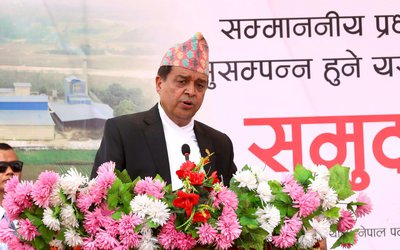
Flash floods have increased and become more unpredictable, and their toll on lives and livelihoods is growing as well. There is much we still don’t know about how to manage floods, but there are key policy actions we can take now.
In Asia and the Pacific, we have entered the season – June through August – for flash floods and landslides. The number of flash floods is increasing, breaking historical records, and bringing with them the associated human, economic, and infrastructure losses and damage, according to the global disaster database EM-DAT.
It is estimated that in 2018 alone, the region incurred flash flood damage of about $3 trillion. Many floods are small and spread across remote locations worldwide, making estimates of their impact difficult, so this might just represent a fraction of the actual figure. Mountainous countries like Afghanistan, the People’s Republic of China, India, Indonesia, Nepal, Pakistan, the Philippines, Thailand, and Sri Lanka tend to top the list of countries highly impacted by flash floods.
Tracking the impact of floods is complex because they come in many forms and for myriad reasons. Flash floods are often triggered by excessive rain on mountain slopes, sudden release of water from reservoirs or other reasons. They can occur in small watersheds at any time of the day and are dangerous because they combine incredible velocity with destructive power.
In mountain regions, communities living in lower areas might not even notice heavy rain but could still suffer from flash floods. Changing rainfall patterns cause landslides and flash floods in communities that might have never before experienced such disasters.
Flash floods frequently cause landslides in hilly and mountainous areas and vice versa. For settlements in a coastal area near a mountainous region, a typhoon or torrential rainfall coinciding with a tidal surge will also trigger high magnitude flash floods. Triggers for flash floods include other natural causes (e.g., glacial lakes outbursts), and artificial dam breaches.
There are few studies conducted to understand the cause and effect of the increasing trend of flash floods. One of the most widely blamed factors is the increased frequency of typhoons and torrential rains. Human encroachment within river corridors or flood plains and dumping of construction debris and other waste in rivers are other factors reducing the flow of rivers, resulting in frequent and high magnitude flash floods.
Flash floods are not only the result of the rainfall-runoff relationship but also the consequence of other geophysical and human-induced processes within the watershed, including land-use changes, urbanization and population growth.
Millions of people continue to live in informal settlements on the banks of rivers, which are geologically very fragile. In general, many of these small watersheds and rivers have lost their natural characteristics over time due to rapid land-cover/land-use changes, which ultimately increase the rainfall-runoff and sediment flow from the watershed while diminishing natural protection.
Unless the right policies are formulated, laws enforced and actions are taken, flash floods will be a major obstacle to maintaining social stability and economic progress in the region.
Interpretation of cause and effects of flash flood disasters are often politically, technically, and strategically biased, which confuses the process of making timely investment decisions. But there are approaches that can be taken, such as the following:
- Harmonize principles such as integrated watershed and water resources management, climate change adaptation, and disaster risk management. Risk management should be an essential part of policies and plans. This is easier to achieve at the local level.
- A flood footprint and accountability mechanism should be promoted within small watersheds. This helps promote upstream-downstream coordination and enforce disaster laws and regulations.
- Local governments urgently need greater expertise on flood management, both on the technical and non-technical aspects, and in each and every stage of the risk management cycle, which is greatly lacking in the region.
- Preparedness and response capacity at local communities should equally be promoted through a community-based approach. This includes building community-to-community coordination. For example, if there is heavy rainfall and a flash flood is likely in an upstream community, that community can inform the downstream community and activate an alert system—which should be installed.
- Rainfall forecasts, flood forecasts, and early warning systems give different meanings at different times. Therefore, clear boundaries are needed. With the increased use of high-level technologies, regular watershed monitoring and flash flood early warning systems can be enhanced at all levels.
- Hazard zone identification should not only be done based on historical hydrological records and observations. It should capture other phenomena in the watershed as well, if possible.
- Spatial planning (including land use, urban, transport, and environmental planning) plays a key role. Some conventional activities such as slope farming requiring frequent land preparation therefore yielding more sediment production can be replaced by high-value and long-term fruit and orchid production with proper food security planning.
- “Green-gray” infrastructure like retention basins, wetlands, vegetation shields, sediment traps, floodwalls, diversion channels, retaining walls, and other measures can improve the geo-morphology of the mountain rivers including slope stabilization and overall flash flood risk management.
Unless the right policies are formulated, laws enforced and actions are taken, flash floods will be a major obstacle to maintaining social stability and economic progress in the region.
Flash floods are increasing. Our understanding and actions to address them need to increase as well.
Source: ADB BlogADB Blog
Rabindra P. Osti is Senior Water Resources Specialist, East Asia Department, ADB















